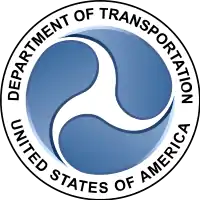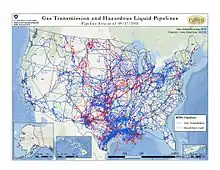Pipeline and Hazardous Materials Safety Administration
The Pipeline and Hazardous Materials Safety Administration (PHMSA) is a United States Department of Transportation agency created in 2004, responsible for developing and enforcing regulations for the safe, reliable, and environmentally sound operation of the US's 2.6 million mile pipeline transportation. It is responsible for nearly 1 million daily shipments of hazardous materials by land, sea, and air. It oversees the nation's pipeline infrastructure, which accounts for 64 percent of the energy commodities consumed in the United States.[2] Made up of the Office of Pipeline Safety (OPS) and the Office of Hazardous Materials Safety (OHMS).
 Seal of the United States Department of Transportation | |
 Logo of the PHMSA | |
 Headquarters of the Pipeline and Hazardous Materials Safety Administration | |
| Department overview | |
|---|---|
| Formed | July 1, 2004 |
| Jurisdiction | Federal government of the United States |
| Headquarters | 1200 New Jersey Avenue, SE, Washington, D.C. 20590 38°52′32.92″N 77°0′10.26″W |
| Employees | 500 (approx.) (Nov. 2017) |
| Annual budget | $244.5 million USD (FY2015, enacted)[1] |
| Department executives |
|
| Parent department | United States Department of Transportation |
| Child agencies |
|
| Website | phmsa |
PHMSA was created within the U.S. DOT under the Norman Y. Mineta Research and Special Programs Improvement Act of 2004,[3] which former United States President George W. Bush signed into law on November 30, 2004.
Regulatory base
The PHMSA enforces the Natural Gas Pipeline Safety Act of 1968(Pub.L. 90–481), which was enacted in response to the Richmond, Indiana, explosion, as well as the Hazardous Liquid Pipeline Act of 1979 (Pub.L. 96–129), the Pipeline Safety Improvement Act of 2002, the Pipeline Inspection, Protection, Safety and Enforcement Act (PIPES) Act of 2006, the Pipeline Safety, Regulatory Certainty, and Job Creation Act of 2011 (P.L. 112), regulations (49 CFR Parts 190-199) and other statutes.
History
Prior to 2005 the U.S. Department of Transportation had no focused research organization and no separately operating administration for pipeline safety and hazardous materials Transportation safety in the United States. The Norman Y. Mineta Research and Special Programs Improvement Act of 2004 provided these, with an opportunity to establish mode government budget and information practices in support of then president Bush's 'Management Agenda' initiatives.[4] Prior to the Special Programs Act of 2004, PHMSA's hazmat and pipeline safety programs were housed within the Transportation Department's Research and Special Programs Administration, known as RSPA.[5]
Office of Hazardous Materials Safety (OHMS)
OHMS oversees the transportation of hazardous materials by air, rail, highway, and water, with the exception of bulk transportation of hazmat by vessel. OHMS promulgates a national safety program, which consists of: evaluating safety risks, developing and enforcing standards for transporting hazardous materials, educating shippers and carriers, investigating hazmat incidents and failures, conducting research, providing grants to improve emergency response to incidents.[6]
The OHMS website includes OHM guidance documents, hazmat carriers' special permits and approvals information, reports and incidents summaries, penalty action reports, registration information and forms, the Emergency Response Guidebook for First Responders, Freedom of Information Act requests, and the Hazardous Materials Emergency Preparedness (HMEP) grants program.
Office of Pipeline Safety (OPS)

OPS oversees the 2.3 million miles of the natural gas pipeline system in the United States and its hazardous liquid pipelines.[7] As of May 2014 about 80 percent of the funds states spend on pipeline safety comes from PHMSA.[8]
Several agencies collaborate on the 'federal pipeline safety program', authorized through the fiscal year ending September 30, 2015 such as the Transportation Security Administration,the Department of Homeland Security, and the Federal Energy Regulatory Commission.[9]
The Pipeline Risk Management Information System (PRIMIS) consists of integrity management programs originally created for transmission pipelines and has led to a reduced amount of pipeline accidents.[10] In 2001 the Liquid Integrity Management Program (LIMP)came into law, followed by the 2003 Transmission Integrity Management Program (TIMP) and the 2008 Distribution Integrity Management Program (DIMP).
The 'Accountable Pipeline Safety and Partnership Act of 1996' requires that OPS adopt rules requiring interstate gas pipeline operators to provide maps of their facilities to the governing body of each municipality, in which the pipeline is located. The National Pipeline Mapping System (NPMS) was removed for a number of months from public use after September 11, due to security concerns. In 2012, it returned with restriction of use. National Pipeline Maps can still be bought from PennWell Corporation.[11]
As of 2014, OPS and PMHSA respectively, have not set minimum qualifications for state inspectors, who lead inspection teams. In one state, for example, an inspector with less than one year's experience was allowed to lead inspections.[12]
Pipeline safety record
In the years 1996-2015, Pipeline and Hazardous Materials Safety Administration (PHMSA) reported a total of 11,199 pipeline incidents[lower-alpha 1] in a system that includes a total of 2,509,667 miles (4,038,918 km) of gas pipelines and 208,494 miles (335,539 km) of hazardous liquids pipelines in the United States as of 2015. 856 of those were considered "serious incidents",[lower-alpha 2] 86 were serious incidents involving hazardous liquids pipelines.[14] This is an average of approximately 560 incidents per year in the last 20 years for all types of pipelines. These incidents caused a total of 360 fatalities and 1,376 injuries.[14] More recent data however reveals that pipeline incidents as well as the total number of releases has decreased by over 50% since PHMSA was created and pipelines now safely deliver over 99.999% of all shipments, the highest safety percentage of any transportation system.[15]
Regulatory failures
The 2010 San Bruno pipeline explosion of a Pacific Gas and Electric Company (PG&E) gasline in San Bruno, California, a suburb south of San Francisco, killed eight people, injured 58 and destroyed much of a subdivision. Investigators from the National Transportation Safety Board found weak state and federal oversight.[16] The long term costs for pipeline inspection and safety upgrades will be borne at 55% by electricity rate payers per California Public Utilities Commission judgement[17] On 1 April 2014 PG&E was indicted in U.S. District Court, San Francisco, California, for multiple violations of the Natural Gas Pipeline Safety Act of 1968 relating to its record keeping and pipeline "integrity management" practices.[18]
In 2011, the PHMSA came under criticism for not releasing a Canadian company’s plans for managing oil spills and estimating a worst-case scenario in the event its pipeline burst in the US.[19] Then Transportation Secretary Ray LaHood, who oversaw the pipeline agency, acknowledged weaknesses in the program and asked Congress to pass legislation that would increase penalties for negligent operators and authorize the hiring of additional inspectors.[20] Federal records showed that although the pipeline industry reported 25 percent fewer significant incidents from 2001 through 2010 than in the prior decade, the amount of hazardous liquids being spilled remained substantial. There were more than 100 significant spills each year, a trend that dates back more than 20 years. The percentage of dangerous liquids recovered by pipeline operators after a spill dropped considerably.[20]
In 2013, PHMSA's Jeffrey Wiese told several hundred oil and gas pipeline compliance officers that his agency has "very few tools to work with", in enforcing safety rules, even after Congress in 2011 allowed it to impose higher fines on companies that cause major accidents. "Do I think I can hurt a major international corporation with a $2 million civil penalty? No," he said.[21] These comments reflect the growing trend toward creating industry standards, in order to "drive safety through the adoption of Safety Management Systems (SMS) in regulated communities."[22]
A May 2014 report by the Office of Inspector General for the Department of Transportation[12] found the PHMSA did not ensure "that key state inspectors are properly trained, inspections are being conducted frequently enough and inspections target the most risky pipelines".[8]
Leadership
At the end of FY2012, PHMSA employed 203 staff in total, including 135 inspection and enforcement staff.[9] Timothy P. Butters is the acting Administrator, since Cynthia L. Quarterman left in October 2014.
The PMHSA has a 'senior leadership team' of eight people with the following positions: Administrator, Deputy Administrator, Chief Safety Officer, Chief Counsel, two Directors and three Associate Administrators. The current leadership team includes:
| Name | Position | Sworn in |
|---|---|---|
| Howard R. Elliott | Administrator | October 30, 2017 |
| Drue Pearce | Deputy Administrator | August 7, 2017 |
Past leadership includes
- Brigham McCown, first acting administrator July 1, 2005 until March 31, 2006 and first Deputy Administrator, July 1, 2005 until January 1, 2007.
- Thomas J. Barrett, first permanent Administrator from March 31, 2006 until late 2007.
- Stacey Gerard, first Assistant Administrator/Chief Safety Officer, first acting Deputy Administrator until July 1, 2005.[23]
- Krista Edwards, Chief Counsel in 2006, Deputy Administrator, acting Administrator in late 2007.[24]
- Carl T. Johnson, Administrator from January 9, 2008 until 2009.
- Cynthia L. Quarterman, Administrator from 2009 until October 2014.
- Timothy Butters, acting Administrator from late 2014. until June 8, 2015.
- Marie Therese Dominguez, Administrator from October 7, 2015 until 2016.
- Howard "Skip" Elliott, Administrator from October 30, 2017 to present.
See also
- List of North American natural gas pipelines
- List of pipeline accidents in the United States in the 21st century
- Weld monitoring, testing and analysis
- Robotic Non-Destructive Testing
- Intelligent pigging
- Emergency Response Guidebook
Notes
- An incident is defined as:"(1) An event that involves a release of gas from a pipeline, or of liquefied natural gas, liquefied petroleum gas, refrigerant gas, or gas from an LNG facility, and that results in one or more of the following consequences: (i) A death, or personal injury necessitating in-patient hospitalization; (ii) Estimated property damage of $50,000 or more, including loss to the operator and others, or both, but excluding cost of gas lost; (iii) Unintentional estimated gas loss of three million cubic feet or more; (2) An event that results in an emergency shutdown of an LNG facility. Activation of an emergency shutdown system for reasons other than an actual emergency does not constitute an incident. (3) An event that is significant in the judgment of the operator, even though it did not meet the criteria of paragraphs (1) or (2) of this definition."[13]
- Serious Incidents include a fatality or injury requiring in-patient hospitalization.
References
- FY 2017 Department of Transportation Budget Request Archived 2017-04-29 at the Wayback Machine, pg 7, United States Department of Transportation, Accessed 2019-9-8
- "U.S. House of Representatives Committee on Transportation and Infrastructure: Hearing on Implementation of Pipeline Inspection, Protection, Enforcement, and Safety Act of 2006" (PDF). Archived from the original (PDF) on 2009-03-25. Retrieved 2018-06-01.
- "United States Statutes at Large, Volume 118, 108th Congress, 2nd Session". Gpo.gov. Retrieved 30 November 2014.
- John, McCain (2004-10-08). "Text - S.2952 - 108th Congress (2003-2004): Norman Y. Mineta Research and Special Programs Improvement Act". www.congress.gov. Retrieved 2018-04-05.
- "Agencies - Research and Special Programs Administration". Federal Register. Retrieved 2018-04-05.
- "PHMSA - About Hazmat". Phmsa.dot.gov. 2008-04-30. Archived from the original on 2009-01-07. Retrieved 2012-02-23.
- "PHMSA - About Pipeline". Phmsa.dot.gov. 2008-04-30. Archived from the original on 2012-02-16. Retrieved 2012-02-23.
- Lowy, Joan (9 May 2014). "Watchdog says federal agency fails to ensure states are overseeing gas, other pipeline safety". Star Tribune, AP. Archived from the original on 12 May 2014. Retrieved 11 May 2014.
The federal effort is so riddled with weaknesses that it's not possible to ensure states are enforcing pipeline safety.
- Paul W. Parfomak. "Keeping America's Pipelines Safe and Secure: Key Issues for Congress, Paul W. Parfomak Specialist in Energy and Infrastructure Policy January 9, 2013" (PDF). Congressional Research Service Report for Congress. Congressional Research Service. Archived from the original on 4 June 2014. Retrieved 30 November 2014.CS1 maint: bot: original URL status unknown (link)
- "Pipeline Risk Management Information System (PRIMIS)". Pipeline and Hazardous Materials Safety Administration. n.d. Retrieved 30 November 2014.
- "NPMS – Home". Pipeline and Hazardous Materials Safety Administration. Retrieved 30 November 2014.
- Office of Inspector General (7 May 2014). "PHMSA's State Pipeline Safety Program Lacks Effective Management and Oversight". Audit AV-2014-041. Department of Transportation. Archived from the original on 11 May 2014. Retrieved 11 May 2014.
- "Gas Distribution, Gas Gathering, Gas Transmission, and Liquefied Natural Gas (LNG) Incidents" (PDF). Oracle BI Interactive Dashboards - SC Incident Trend. Pipeline and Hazardous Material Safety Administration. May 27, 2014. Retrieved November 15, 2014.
- "Pipeline Incident 20 Year Trends (All-Reported Incident 20 Year Trends)". hip.phmsa.dot.gov. Retrieved 2016-11-16.
- "Pipeline Incident 20 Year Trends | PHMSA". www.phmsa.dot.gov. Retrieved 2018-04-05.
- "Pacific Gas and Electric Company Natural Gas Transmission Pipeline Rupture and Fire" (Pipeline Accident Report). NTSB Number: PAR-11-01. National Transportation Safety Board. 9 September 2010. Retrieved 11 May 2014.
- Leff, Lisa (Dec 20, 2012). "PG&E customers to foot part of pipe safety costs". Associated Press. Retrieved 12 May 2014.
- "PG&E Charged with Multiple Violations of the Natural Gas Pipeline Safety Act". Press Release. Department of Justice. 1 April 2014. Retrieved 11 May 2014.
- "News - U.S. Regulators Refuse to Release Spill Hazard Estimates for Pipeline from Canada". AllGov. 2011-02-09. Retrieved 2012-02-23.
- "Pipeline Spills Put Safeguards Under Scrutiny". The New York Times. Retrieved 30 November 2014.
- http://insideclimatenews.org/news/20130911/exclusive-pipeline-safety-chief-says-his-regulatory-process-kind-dying
- "Pipelines and Hazardous Materials Safety Administration: Top Policy Issues". US Department of Transportation. 2017-01-27. Retrieved 2018-04-05.
- "Stacey Gerard Begins Role as First Pipeline and Hazardous Materials Safety Administration Assistant Administrator/Chief Safety Officer" (PDF). Phmsa.dot.gov. Archived from the original (PDF) on 29 October 2013. Retrieved 30 November 2014.
- "PHMSA - Press Release - Announcement Archive - PHMSA Press Release 02-07". Phmsa.dot.gov. Archived from the original on 4 December 2014. Retrieved 30 November 2014.
External links
- Official website

- Pipeline and Hazardous Materials Safety Administration in the Federal Register
- PHMSA Public Map Viewer - Application enables the user to view the National Pipeline Mapping System (NPMS) data one county at a time. The user may zoom in to a map scale of 1:24,000.
- Buckeye's Liquid Transmission Pipeline Integrity Management Program
- PennWell maps
- Full List of US Pipeline Regulatory Bodies by State / Territory The US State / Territory enforcement agencies for PHMSA